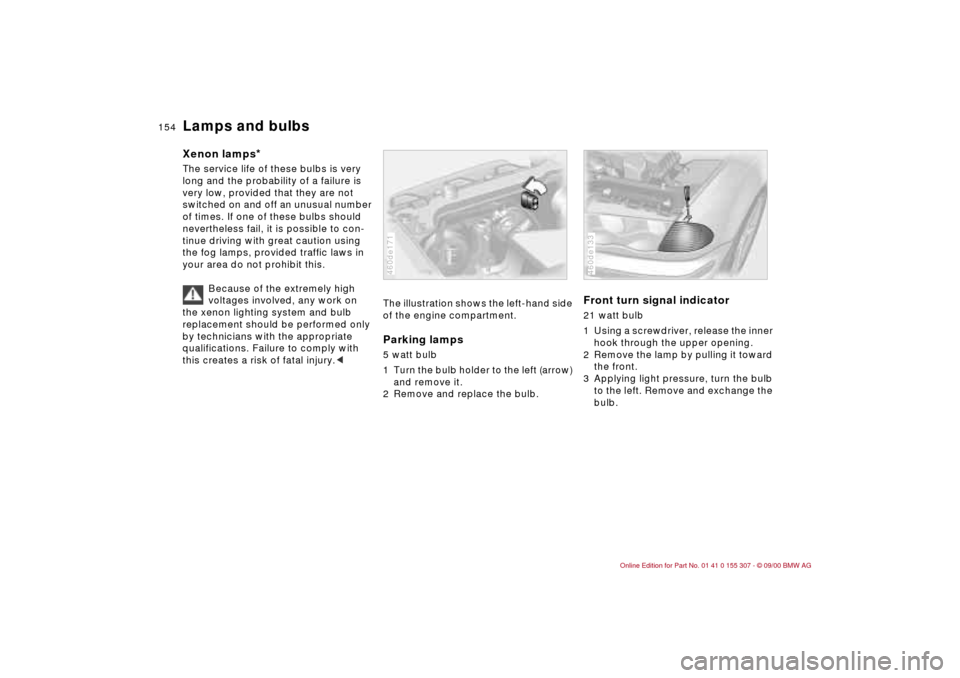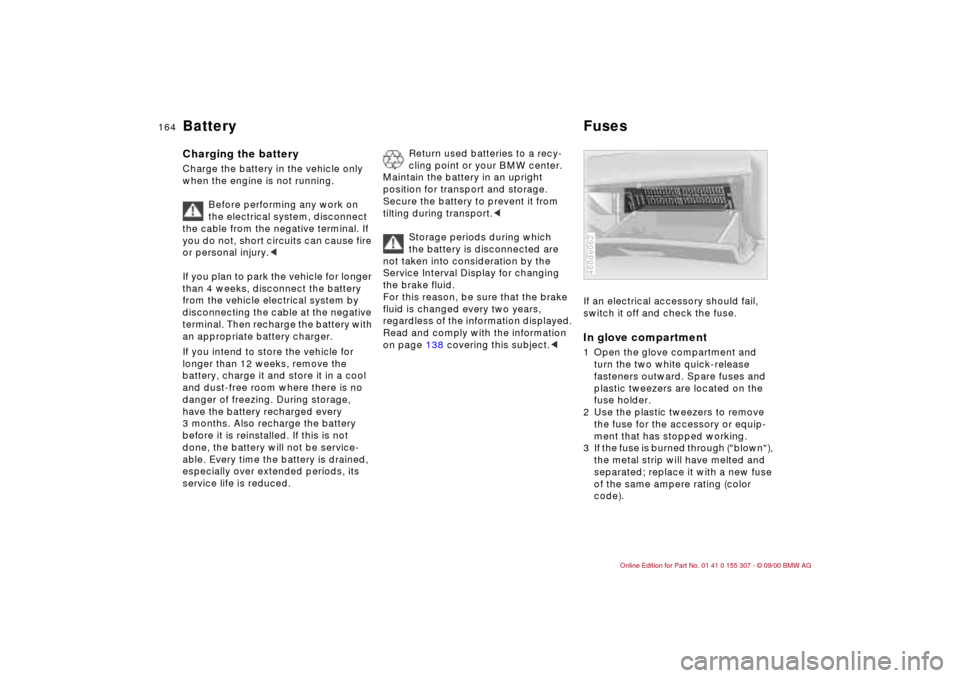Page 154 of 203

154n
Lamps and bulbsXenon lamps
*
The service life of these bulbs is very
long and the probability of a failure is
very low, provided that they are not
switched on and off an unusual number
of times. If one of these bulbs should
nevertheless fail, it is possible to con-
tinue driving with great caution using
the fog lamps, provided traffic laws in
your area do not prohibit this.
Because of the extremely high
voltages involved, any work on
the xenon lighting system and bulb
replacement should be performed only
by technicians with the appropriate
qualifications. Failure to comply with
this creates a risk of fatal injury.<
The illustration shows the left-hand side
of the engine compartment.Parking lamps5 watt bulb
1 Turn the bulb holder to the left (arrow)
and remove it.
2 Remove and replace the bulb.460de171
Front turn signal indicator 21 watt bulb
1 Using a screwdriver, release the inner
hook through the upper opening.
2 Remove the lamp by pulling it toward
the front.
3 Applying light pressure, turn the bulb
to the left. Remove and exchange the
bulb.460de133
Page 162 of 203

162n
Changing a wheel Battery Driving with the space-saver tireDrive cautiously. Do not exceed a speed
of 50 mph (80 km/h).
You can anticipate changes in vehicle
handling such as delayed braking re-
sponse, longer braking distances and
changes in self-steering properties in
marginal stability limits.
The changes in handling characteristics
will be even more pronounced in
conjunction with winter tires.
Only one space-saver tire may be
mounted at one time. Reinstall
wheels and tires of the same size and
specification as soon as possible.
Maintain correct tire pressures. Refer to
page 29.<
Installation locationThe battery is in the right rear of the
luggage compartment. Release side
trim panel and remove. Fold back the
cover panel.
Battery posts, terminals, and
related accessories contain lead
and lead compounds. Wash hands after
handling.<
Charge conditionYou can read the charge condition
of the battery with the "Magic Eye
*"
(= a hydrometer):
>Green: adequate charge.
>Black: not charged adequately.
The battery must be recharged.
Please contact your BMW center
for additional information.
>Yellow: replace the battery.
The service life specified for the
battery can be achieved only if it is
always kept adequately charged. If the
vehicle is primarily used for stop-and-
go traffic, be sure to check the charge
status often.<
463us006
Page 164 of 203

164n
Battery FusesCharging the battery Charge the battery in the vehicle only
when the engine is not running.
Before performing any work on
the electrical system, disconnect
the cable from the negative terminal. If
you do not, short circuits can cause fire
or personal injury.<
If you plan to park the vehicle for longer
than 4 weeks, disconnect the battery
from the vehicle electrical system by
disconnecting the cable at the negative
terminal. Then recharge the battery with
an appropriate battery charger.
If you intend to store the vehicle for
longer than 12 weeks, remove the
battery, charge it and store it in a cool
and dust-free room where there is no
danger of freezing. During storage,
have the battery recharged every
3 months. Also recharge the battery
before it is reinstalled. If this is not
done, the battery will not be service-
able. Every time the battery is drained,
especially over extended periods, its
service life is reduced.
Return used batteries to a recy-
cling point or your BMW center.
Maintain the battery in an upright
position for transport and storage.
Secure the battery to prevent it from
tilting during transport.<
Storage periods during which
the battery is disconnected are
not taken into consideration by the
Service Interval Display for changing
the brake fluid.
For this reason, be sure that the brake
fluid is changed every two years,
regardless of the information displayed.
Read and comply with the information
on page 138 covering this subject.<
If an electrical accessory should fail,
switch it off and check the fuse. In glove compartment1 Open the glove compartment and
turn the two white quick-release
fasteners outward. Spare fuses and
plastic tweezers are located on the
fuse holder.
2 Use the plastic tweezers to remove
the fuse for the accessory or equip-
ment that has stopped working.
3 If the fuse is burned through ("blown"),
the metal strip will have melted and
separated; replace it with a new fuse
of the same ampere rating (color
code).460de062
Page 178 of 203
178n
Tire Pressure Control (RDC)
*
This system regularly checks tire pres-
sure and monitors all four tires even
while driving, so you do not have to.
Behind the valve stem in every wheel,
there is an electronic chip which is
designed for severe-duty applications
and long service life. It contains a pres-
sure sensor, a transmitter and a battery.
The pressure is measured in extremely
short time intervals and then transmitted
by a radio signal. If an irregularity is
detected, the transmission rate is
increased. 463de006
There is an antenna located right near
every wheel in the vehicle body. This
antenna picks up signals from its
respective wheel. A central electronics
system evaluates the quadruple signals
which it receives and forwards any
changes.
The RDC provides an important contri-
bution to driving safety.
Page 187 of 203
187n
IndexDataTechnologyRepairsCar careControlsOverview
Capacities
Notes
Fuel tank
reserve gal. (liters)
gal. (liters)approx. 16.6 (approx. 63)
approx. 2.1 (approx. 8)Fuel specification: page 28
Windshield washer system/
Headlamp washer system (front)
Rear window washer system (rear)quarts (liters)
quarts (liters)approx. 5.6 (approx. 5.3)
approx. 2.4 (approx. 2.3)For details: page 134
Cooling system including heater circuit quarts (liters) approx. 8.9 (approx. 8.4) For details: page 137
Engine oil filter change quarts (liters) 325i approx. 6.9
(approx. 6.5)
325xi: approx. 7.9
(approx. 7.5)BMW High Performance
synthetic oil
Specifications: page 136
Manual and automatic transmission and
differentialÐ Lifetime fluid, no fluid change
required